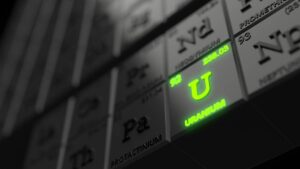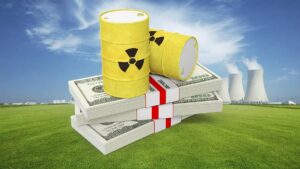Nuclear option: Is uranium our only choice remainium?

Via Getty
You might not never know it but us green-talking Australians have been involved in matters of nuclear importance ever since some idiot split an atom.
That idiot, among others, was Sir Marcus Laurence Elwin “Mark” Oliphant, AC, KBE, FRS, FAA, FTSE – a South Australian physicist and humanitarian who worked with Ernest Rutherford in Britain on nuclear physics, playing an important role in the first experimental demonstration of nuclear fusion and in the development of the first atom bomb at the Manhattan Project.
Foreign Minister Bert Evatt was the first president of the UN Atomic Energy Commission in 1946, a body set up ‘to deal with the problems raised by the discovery of atomic energy’.
But Australians in general have always been in two minds about nuclear technology. It is OK to sell uranium to world markets provided our atoms are only used to generate electricity? It is not OK to construct nuclear reactors in Australia? It was OK during the Cold War to consider getting our own nuclear weapons, but not OK even to consider acquiring them at the Cold War’s end.
It is now OK for Australia to be the first non-nuclear weapons state to acquire nuclear-propelled submarines. But it is not OK to arm them with their natural accompaniment – nuclear ballistic missiles.
Australia’s plan to acquire nuclear submarines under the AUKUS trilateral security partnership enjoys support from 70% of the country’s public, a poll released recently shows, as a growing number of people view Russia and China as threats.
The results of an annual survey by the Lowy Institute, a Sydney-based think tank, come after Australia, the UK and the US unveiled AUKUS in September.
As part of the pact, the two other members will help Australia acquire nuclear-powered submarines.
Last week, according to the latest Lowy Institute poll, a full third of respondents were “strongly in favour” of Australia obtaining the submarines, while another 37% were “somewhat in favour.”
One feels DFAT will need to update its website.
“In February 1970, Australia decided to forego the possible pursuit of nuclear weapons by signing the Nuclear Non-proliferation Treaty (NPT).
Since then, Australia has been one of the treaty’s strongest supporters. In 1995, we collectively succeeded in ensuring the Treaty was extended indefinitely.”
In 1986 Australia joined the South Pacific Nuclear Free Zone Treaty (Treaty of Rarotonga) and is bound to the deal and obligations through the South Pacific Nuclear Free Zone Treaty Act. Again, we’d better call the webmaster at DFAT.
“The treaty prohibits States Parties from the manufacture, production or acquisition of nuclear explosive devices; research and development relating to their manufacture or production; the possession or control over such devices; the stationing of nuclear explosive devices in their territories; and the testing of nuclear explosive devices in the region.”
The Lowy poll which collected nuclear ideas from roughly 2,000 Australian adults, mostly in March, found just 11% of us “strongly against” the nuclear subs while 17% were “somewhat against” it.
It’s a pretty incredible turnaround, with the traditional anti-nuclear sentiment in Australia.
A full 63% of respondents in the poll either strongly or somewhat opposed Australia acquiring nuclear weapons. Just 11% strongly favoured obtaining nuclear weapons, while 25% were somewhat in favour.
The uranium bulls are pretty excited right now
We’ve been having a few power problems of our own lately.
There’s some big conversations happening and not a heap of really gripping solutions that don’t smack of madness, fraud or dreamy dreams.
According to Stockhead’s Emma Davies, International Atomic Energy Agency’s (IAEA) Uranium Production Specialist Dr Adrienne Hanly has flagged that uranium inventories are precariously low.
At the recent World Nuclear Fuel Cycle conference in London, Dr Hanly said uranium fuel inventory levels for US nuclear utilities are at just 16 months of requirements – below the recommended 2+ years minimum.
The nuclear fuel has a new lease on life as a mooted solution to the issue of providing firming electricity to accompany the expanding rollout of wind and solar as Western governments try (though at this point they seem to be largely failing) to wean themselves off fossil fuels.
And as Josh Chiat pointed out last week, spot prices may have fallen from above US$60/lb a couple months ago to US$47.50/lb, but that makes the sector a whole lot more investable now than it did five years ago, when prices of US$18/lb made turning a profit in the field a nigh on impossible task.
Friends with everyone, Reuben Deputy Edwards-er Adams, wrote that only last year the famed mining investor, president and founder of Rule Investment Media, Mr Rick Rule of no fixed address, said the easy money in uranium had been made.
Onya Rick, thanks.
But as Reuben points out, things change, and the uranium price is doing some rather interesting things in 2022.
Uranium stocks have mirrored movements in the spot price like last month’s 11-year high of US$65/pound – the magic number often touted by uranium players that would push them to get into production – and the subsequent plunge back below $US50/lb.
So while the tide of public opinion turns, the demand and supply cycle spins, and energy investors start picking sides, here are some ASX uranium businesses which Rick and the rest reckon still have a case to make.
Uranium rules:
Boss Energy (ASX:BOE) recently announced it would restart the Honeymoon uranium mine over in South Australia after nine years in mothballs.
Boss flagged the final investment decision in March with a $125 million share placement which, along with a strategic uranium stockpile of 1.25Mlb worth an estimated US$59.38m, should help fund it into production.
The 2.45Mlb per annum yellowcake mine, which will cost around $113 million to construct and refurbish, will be just the third operating in Australia alongside BHP’s (ASX:BHP) Olympic Dam and the privately owned Beverley mine, also in SA.
Boss plans to be in production by the fourth quarter of 2023 with a three-year ramp-up to its full production rate, timed for a looming nuclear supply shortage expected from 2024.
Honeymoon is set to operate for an initial life of 11 years, with an IRR of 47% at a uranium price of US$60/lb.
While market conditions are vastly improved, Rio Tinto (ASX:RIO) is now chasing more cash so it can close what was until recently one of just three operating uranium mines in Australia.
And Energy Resources of Australia (ASX:ERA) – 86% owned by Rio and the owner and operator of the Ranger mine in the Northern Territory that is surrounded by the Kakadu National Park – has until January 8, 2026, to fix the joint up and skedaddle after mining stopped on that date last year.
It will be a rare test of a major’s ability to complete a full and comprehensive cleanup of a historical mine, something the industry has been less than successful with in the past.
Making that task even harder was a major cost blowout ERA revealed in February this year from $973 million to $1.6-$2.2bn. The schedule is also a concern, with full rehab only expected in Q4 2027 and Q1 2028.
ERA has Rio’s commitment it will help underwrite the bill, something it did in a major equity raise last year.
It will probably need to dip its hands back into its very deep pockets again after ERA confirmed media reports that it was looking at an entitlement offer to boost its coffers.
ERA, which was expecting to make its final U3O8 spot sales this quarter, had just $164 million cash at bank and $535 million held in the Ranger Rehabilitation Trust Fund as of December 31.
Lotus Resources'(ASX:LOT) 43.6Mlb ‘Kayelekera’ project in Malawi – purchased from fellow Africa-focused Paladin Energy (ASX:PDN) in March 2020 – will cost just $US50m to get up and running, the company says.
Kayelekera is a proven uranium operation having successfully produced 11Mlb over five years, ceasing operations in 2014 due to sustained low uranium prices.
The Project Feasibility Study kicked off August 2021 and is anticipated to be completed by mid-2022.
In late March, former producer Paladin (ASX:PDN) raised $200 million from investors to support the planned restart of the Langer-Heinrich uranium mine in Namibia by 2024.
The project, which was placed in care and maintenance in 2018, has a low-cost pathway back to production.
A restart plan previously released by Paladin estimated it would cost US$81m to restart operations, producing at its peak 5.9Mlbs of U3O8 annually at Life of Mine C1 costs of US$27/lb.
With a total mine life of 17 years, that looks very economic at Rule’s incentive price of $US75/lb.
Deep Yellow (ASX:DYL) boss John Borshoff is the geologist who founded Paladin Energy in 1993, before taking it from a junior explorer to a $4bn uranium mining company with two operations – ‘Langer Heinrich’ in Namibia, and ‘Kayelekera’ in Malawi.
In October 2016, Borshoff joined then-$10m market cap uranium explorer DYL as managing director and chief exec.
Deep Yellow, which has three uranium projects in Namibia – Reptile, Nova and Yellow Dune — is now one of a select group of ASX uranium stocks set to enter production once the impending boom hits.
In February this year, a PFS was completed on a ‘Langer-Heinrich-style’ 3mlb per annum open-pit mining operation at the ‘Tumas’ project at Reptile.
Then, in March, DYL announced it had secured support from the board of Vimy Resources (ASX:VMY) for an all-scrip takeover worth $658 million that will increase the chances of developing Vimy’s “world class” Mulga Rock uranium mine in WA.
Related Topics

UNLOCK INSIGHTS
Discover the untold stories of emerging ASX stocks.
Daily news and expert analysis, it's free to subscribe.
By proceeding, you confirm you understand that we handle personal information in accordance with our Privacy Policy.








